Illinois is a gardener’s delight. With its range of USDA Hardiness Zones spanning 5, 6, and 7, you can have your pick of flowers. These zones determine which plants will thrive in which parts of the state. If you’re in the northern regions, you’re looking at Zone 5. Move towards the heart of Illinois, and you’re in Zone 6, while the southernmost parts enjoy the warmth of Zone 7. In this article, we’ve handpicked the 13 best flowers to plant in Illinois, ensuring your garden radiates beauty throughout the seasons.
1. Tall Thimbleweed (Anemone virginiana)
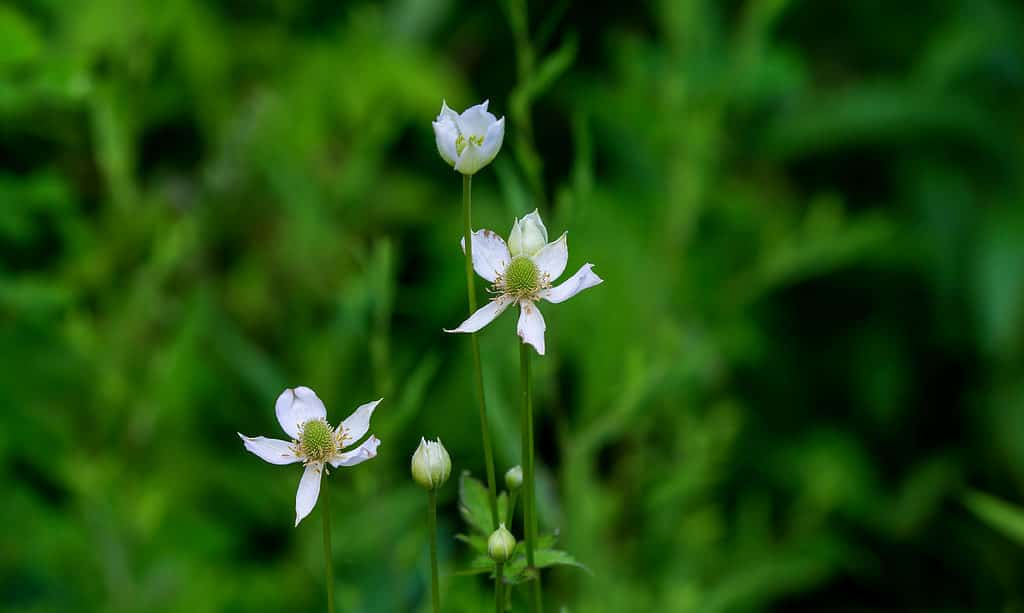
Boasting star-shaped white flowers, the tall thimbleweed is a beautiful plant for your Illinois garden.
©iStock.com/Karel Bock
Tall thimbleweed is a perennial that showcases star-shaped white flowers, each measuring about an inch wide. The center of each flower boasts a unique, thimble-shaped cluster of green stamens. These flowers sit atop upright stems and are complemented by deeply serrated, dark green leaves that form circles midway up the stem.
Unlike some other Anemone varieties, tall thimbleweed spreads gently, ensuring it doesn’t dominate your garden. This beautiful native flower of North America can be spotted in areas with rocky terrains or dry woods, spanning from central USA to eastern regions and into Canada.
For those in Illinois looking for an easy-to-grow flower, this is a top pick. It thrives in ordinary soils that range from slightly dry to moderately moist and can flourish under direct sunlight, partial shade, or even full shade. It’s also resilient to drought and arid soil conditions.
To grow tall thimbleweed, simply plant its seeds in the fall or the start of spring.
2. Common Milkweed (Asclepias syriaca)

Looking to attract pollinators? Plant the common milkweed!
©iStock.com/mr_coffee
Common milkweed is a perennial plant known for its round bunches of aromatic, pink-purple, star-shaped flowers that blossom from early to late summer. These flowers not only add beauty but also serve as a nectar hub for various creatures like butterflies, hummingbirds, bees, and other useful insects. The sturdy stems of the plant carry broad, oval-shaped green leaves with reddish streaks.
It’s an excellent addition to both traditional flower gardens and more natural landscapes. Importantly, milkweed plants play a pivotal role in the lifecycle of monarch butterflies. Incorporating milkweed into your garden can significantly benefit these stunning butterflies.
This plant prefers sunny spots and can thrive in soils ranging from dry to moderately moist. It’s also tolerant of nutrient-poor or gravel-filled soils. However, it’s important to note that milkweed can be toxic if ingested by dogs, cats, or horses, so keep it away from pets!
For those looking to plant milkweed, fall is the ideal time to sow its seeds.
3. Groundplum Milkvetch (Astragalus crassicarpus)
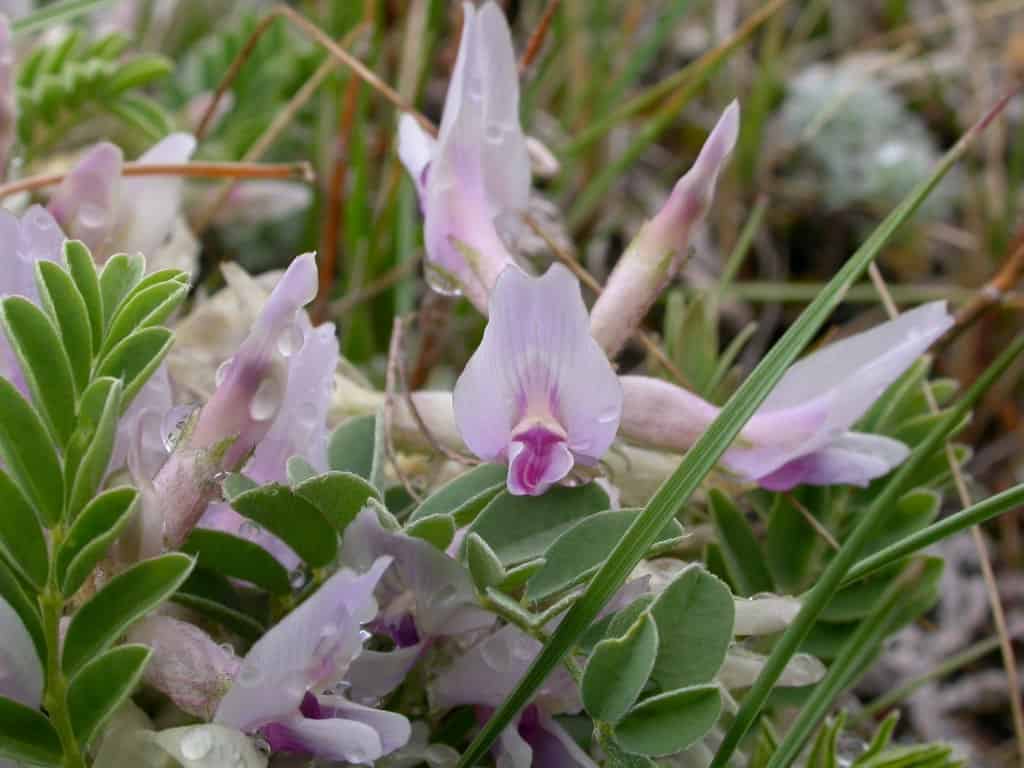
The perennial groundplum milkvetch goes dormant in the summer.
©Matt Lavin from Bozeman, Montana, USA / CC BY-SA 2.0 – Original / License
Groundplum milkvetch is a bushy perennial that sprawls low to the ground, with its stem tips curving upwards. The plant boasts compound, bluish-green leaves made up of 15 to 20 small oval leaflets. From late spring to the onset of summer, this plant showcases clusters of 5 to 15 vibrant pea-like flowers in varying hues of pink, lavender, and blue-violet. Their abundant nectar draws in butterflies and other pollinators.
By the heart of the summer, the groundplum milkvetch takes a rest and goes into a dormant state. It’s a wonderful addition to rock gardens, atop stone walls, or elevated flower beds, especially in areas that are on the drier side. Originating from North America, it’s an excellent fit for Illinois gardens.
This plant thrives in sunlight or partial shade and prefers rocky, gravelly soils that offer good drainage, ranging from dry to moderately moist. However, it’s worth noting that it can be harmful to horses if ingested.
If you’re considering planting this beauty, the best times to sow its seeds are spring or early fall.
4. Cream Wild Indigo (Baptisia bracteata)

In late spring to early summer, cream wild indigo showcases off-white flowers that look like Lupines.
Cream wild indigo is among the first flowers to grace Illinois with its blooms each year. This upright perennial features gracefully curving stems lined with three-part leaves. In the transition from spring to early summer, it showcases elongated clusters of pea-like, off-white flowers reminiscent of Lupines. These flowers, lasting around three weeks, are a favorite among bees, butterflies, and skippers.
This plant shines in open spaces where taller plants don’t overshadow it. It’s an excellent choice for smaller gardens where you want a stunning, low-maintenance perennial that’s sure to last.
It thrives best under direct sunlight in soils ranging from average to moderately moist but well-draining. While it can handle a bit of shade, sunlit spots are its favorite. Resilient to poor soil conditions and drought, once it takes root, there’s little need for extra watering.
To add this beauty to your garden, plant it either in early fall or after the chill of spring’s last frost has passed.
5. Wild Hyacinth (Camassia scilloides)
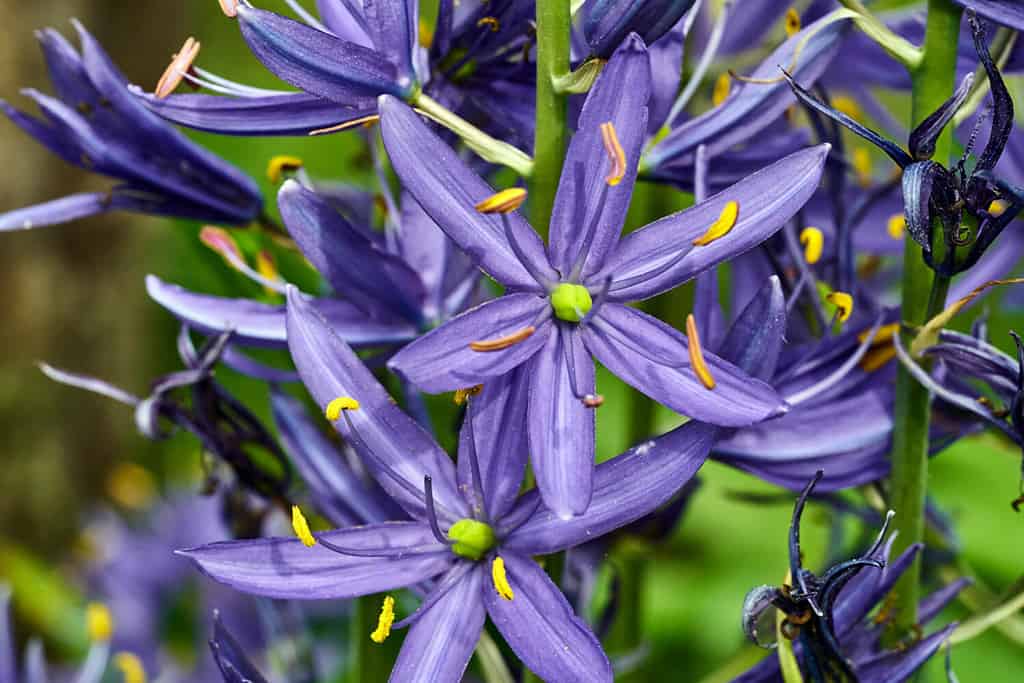
Plant wild hyacinth flowers to attract bees and butterflies to your Illinois garden.
©Jonas Vegele/Shutterstock.com
Wild hyacinth grows as a bulb-based perennial, forming clumps and displaying tall bunches, ranging from 4 to 12 inches, of sweet-smelling, starry flowers. These blooms vary in shade from lavender to an almost translucent blue, highlighted by yellow centers. During spring to early summer, the flowers unfurl gradually, starting from the base upwards, offering a month-long display.
These nectar-rich flowers are a magnet for bees and butterflies. They stand tall on bare stems, surrounded by a base of slender, bright green, grass-like leaves. Interestingly, the bulbs of this plant are edible, serving as a staple for some Native American communities and early settlers from Europe.
For best results, plant wild hyacinth in areas with ample sunlight to light shade, ensuring the soil is rich and retains moisture without being waterlogged. While they appreciate the full sun, they’re pretty adaptable. Plant the bulbs during summer or fall, and watch them sprout with the arrival of the next spring.
6. White Turtlehead (Chelone glabra)

A tall perennial, white turtlehead has unique blooms that last around a month.
©Karel Bock/iStock via Getty Images
White turtlehead stands as a tall perennial that forms clusters, showcasing eye-catching spikes of white or slightly pink flowers from late summer to fall. These unique blossoms, lasting about 3 to 4 weeks, resemble the heads of turtles peeking out from their shells, which is how the plant got its name.
Both butterflies and hummingbirds find these flowers irresistible. Beneath the blooms, a lush mound of dark green leaves enhances the plant’s beauty throughout the season. These leaves, roughly 8 inches in length, have jagged edges and pair up along the plant’s stems, making it a standout among the Chelone family.
White turtlehead thrives in soils rich in organic matter, with a preference for slightly wet conditions and partial shade. If you’re considering adding this flower to your Illinois garden, it’s best to plant it during spring or summer, allowing it ample time to settle in before winter.
7. Large Flower Tickseed (Coreopsis grandiflora)
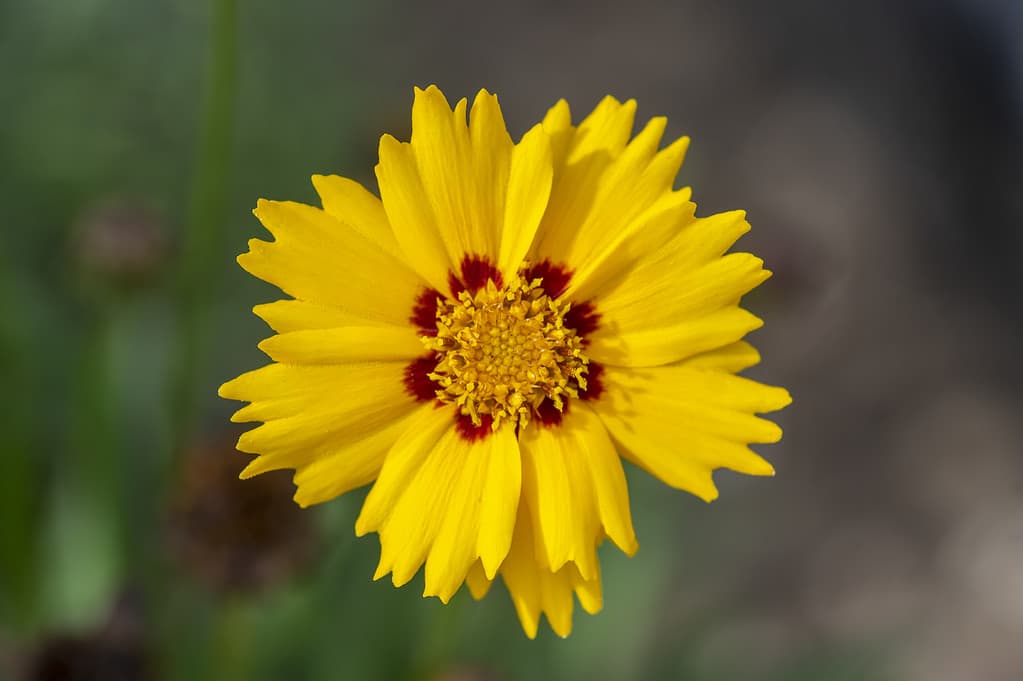
Boasting sunny yellow flowers, large flower tickseed is a great plant for Illinois gardens.
©Iva Vagnerova/iStock via Getty Images
Large flower tickseed brightens up summer gardens as a perennial that flaunts numerous vibrant yellow blooms, spanning 2 to 3 inches, from the end of spring to late summer — especially if you remove faded flowers promptly.
Supported by thin, upright stems adorned with deeply cut bright green leaves, these flowers dance and shimmer with even the faintest wind, bringing dynamic, sunlit movement to gardens. It’s a fantastic choice for edges, rocky gardens, or broad patches for sustained color. This flowering plant has its roots in the central and eastern parts of North America.
For the best growth, it prefers sunny locations with soil that drains well, ranging from dry to moderately moist. It does particularly well in poor, sandy, or stony grounds and can withstand dry conditions once it’s rooted.
Planting is easy from seeds, and if you have mature plants, you can spread their charm by dividing them either in spring or fall every 3 to 4 years.
8. Rock Harlequin (Corydalis sempervirens)
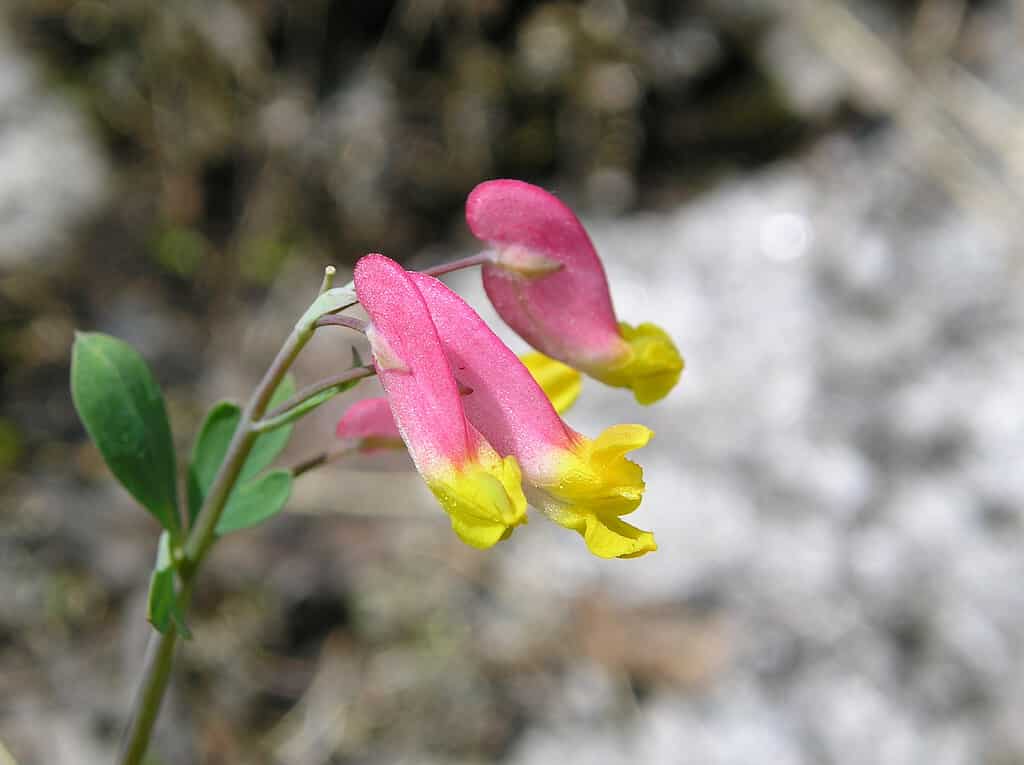
A biennial, the rock harlequin boasts pink flowers in the second year, with a touch of yellow.
Rock harlequin is a biennial known for its intricate leaves and fragile blossoms. In its initial summer, this plant showcases a base of soft, blue-green leaves that are reminiscent of delicate fern patterns, making it attractive even without flowers.
During the second year, this plant flourishes, presenting multiple branches, each adorned with clusters of hanging, light pink flowers with a touch of yellow at the tips, about an inch long. These flowers, which bloom intermittently from the end of spring to fall, offer nectar that attracts a variety of insects like bumblebees and certain butterflies.
Besides its beauty, this enchanting wildflower is also practical, aiding in restoring damaged sites and helping prevent soil erosion. A proud native to Illinois, it’s a fitting choice for local gardens.
For the best results, place rock harlequin in a sunny to partially shaded spot with well-draining, slightly acidic soil. It’s resilient, even thriving in less fertile, dry, or stony grounds. It’s advisable to plant its seeds as summer wanes.
9. Robin’s Plantain (Erigeron pulchellus)
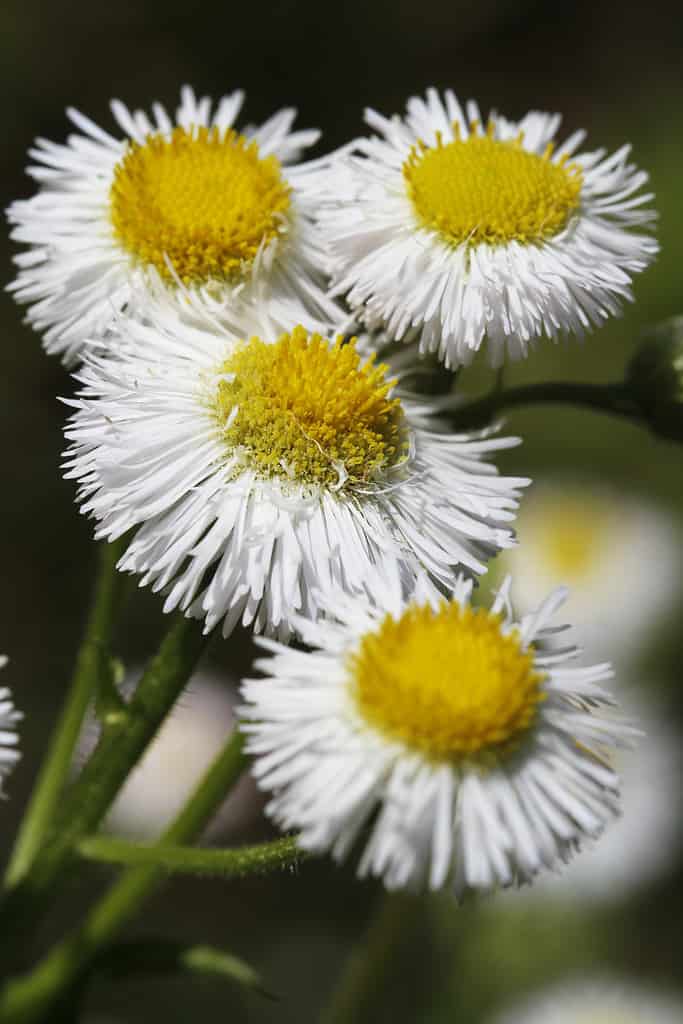
Robin’s plantain boasts eye-catching blooms that come in shades of white to lavender blue.
©kathyclark777/iStock via Getty Images
Among the most eye-catching fleabanes, Robin’s plantain offers a cascade of bright daisies grouped loosely, blooming from mid-spring to the start of summer.
These flowers, about an inch wide, resemble asters with their 50 to 100 slender, lavender-blue to white petals that encircle a yellow core. These lively blooms, which last roughly three weeks, sprout from low-lying bunches of soft, gray-green leaves that are fuzzy to the touch and measure between 2 to 6 inches in length.
Originating from North America, this Erigeron variety naturally spreads, creating a thick and beautiful blanket. When flowering, it serves as a standout ground cover.
It thrives in sunny spots with average, well-draining soil that’s dry to moderately moist. In hotter regions, a bit of shade during peak summer is beneficial. Surprisingly, this plant prefers unfertilized soils. To grow, sprinkle its seeds outdoors either as fall approaches or at the beginning of spring. However, note that only a few of these seeds will take root and sprout.
10. Queen of the Prairie (Filipendula rubra)
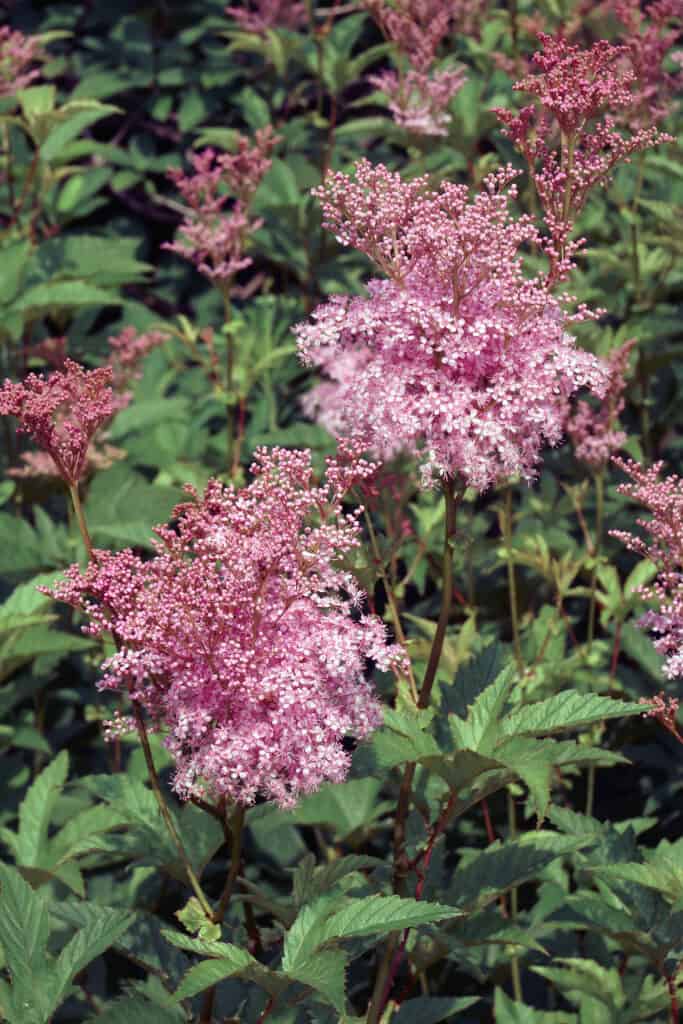
queen of the prairie is native to the United States and a beautiful pick to plant in a flower garden in Illinois.
©iStock.com/nickkurzenko
Standing tall and majestic, the queen of the prairie is an award-winning herbaceous perennial known for its clusters of soft pink flowers that grace gardens from early to late summer. These fluffy blooms elegantly perch on stems, standing out against the backdrop of its bright green leaves.
This hardy native of the U.S. is cherished for both its vibrant foliage and aromatic flowers. It’s an ideal addition for Illinois gardens that embrace a natural vibe, especially in damp woodlands or sunny forest clearings.
It thrives in full sun to partial shade, preferring soil that’s rich and moist. Ensure regular watering, as the Queen of the Prairie doesn’t handle drought well. If you’re thinking of growing it from seeds, either sow them in the soil during fall or keep them stored during winter, then pre-treat and sow in the spring.
11. Water Avens (Geum rivale)
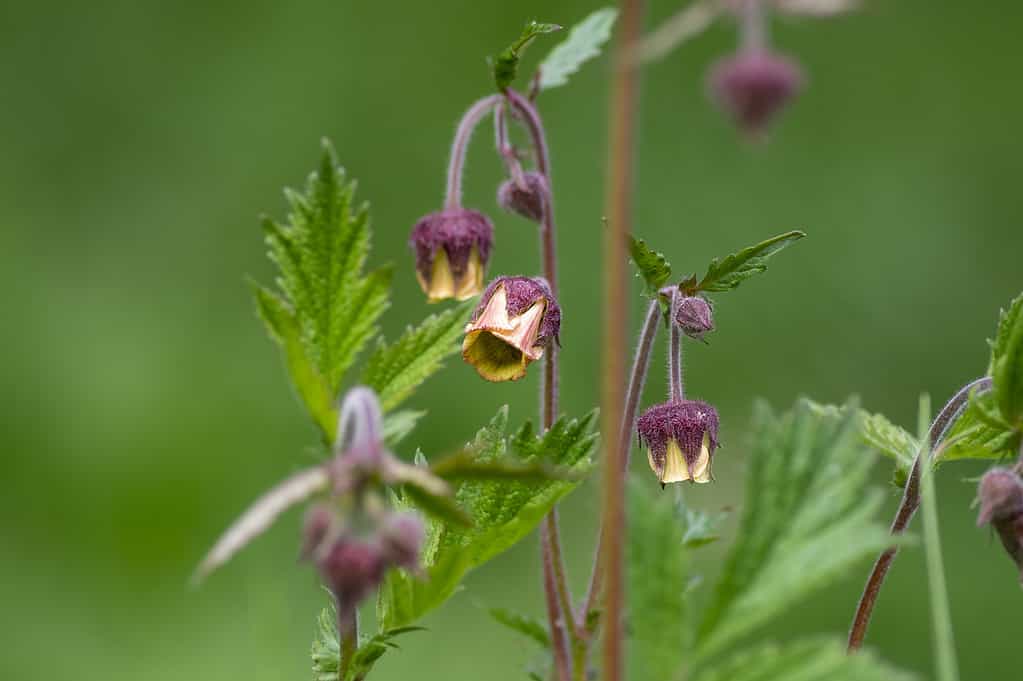
Water avens has bell-like flowers that bloom from late spring to summer.
©Iva Vagnerova/iStock via Getty Images
Loving damp conditions, water avens is a perennial that forms clumps and showcases delicate bell-like flowers in shades from white to pink from late spring through the summer. These blooms, complemented by dark red touches on their stems and sepals, stand tall above the soft, green, lobed leaves.
With its ability to bloom for an extended period, water avens serve as an ideal ground cover, especially in moist areas where many plants can’t thrive. An interesting tidbit: when its roots are boiled, they produce a liquid with a hint of chocolate flavor.
The water avens is happiest in locations with full sunlight or partial shade and needs consistently moist but well-draining soil. To propagate, plant seeds in containers and place them in a cold frame during winter or divide the plant during spring or fall. Removing faded flowers can promote more blossoming.
12. Stiff Sunflower (Helianthus pauciflorus)
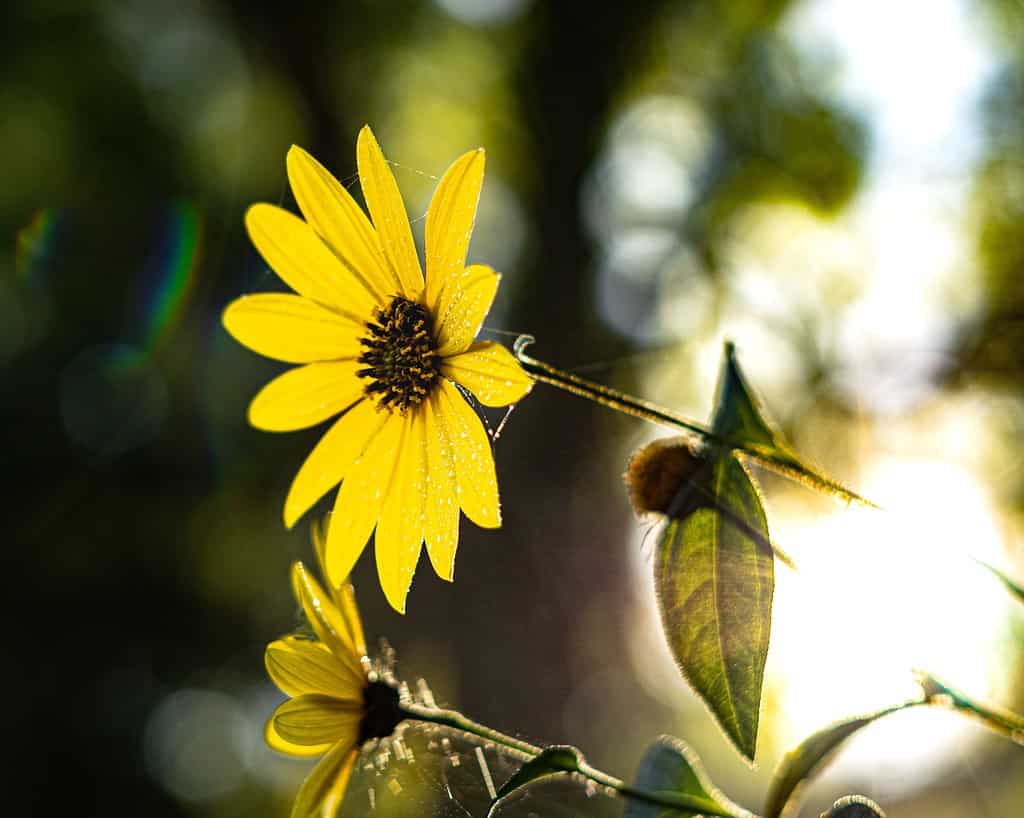
A perennial with firm stems, the stiff sunflower boasts radiant yellow blooms.
©Wirestock/iStock via Getty Images
The stiff sunflower stands tall as a perennial with firm, sometimes reddish stems covered in fine hairs. Its leaves, taking on a grayish-green hue, often fold inwards lengthwise. During early summer to fall, this plant showcases a radiant display of yellow blossoms, each measuring 2 to 4 inches across, with a contrasting purplish-brown center. When the climate turns dry, these sun-loving petals either curl inwards or twist uniquely.
Beyond its beauty, the stiff sunflower is a boon for bees, butterflies, and birds. However, gardeners should note its tendency to spread quickly, making it more suitable for larger spaces rather than compact flower beds.
It performs best in sunny spots with average to slightly dry, well-draining soil. Once rooted, it can withstand drought conditions. When planting its seeds in spring, don’t be surprised if they only sprout the following year. For better results, sowing them in their dormant phase with a cold treatment can improve germination.
13. Cardinal Flower (Lobelia cardinalis)
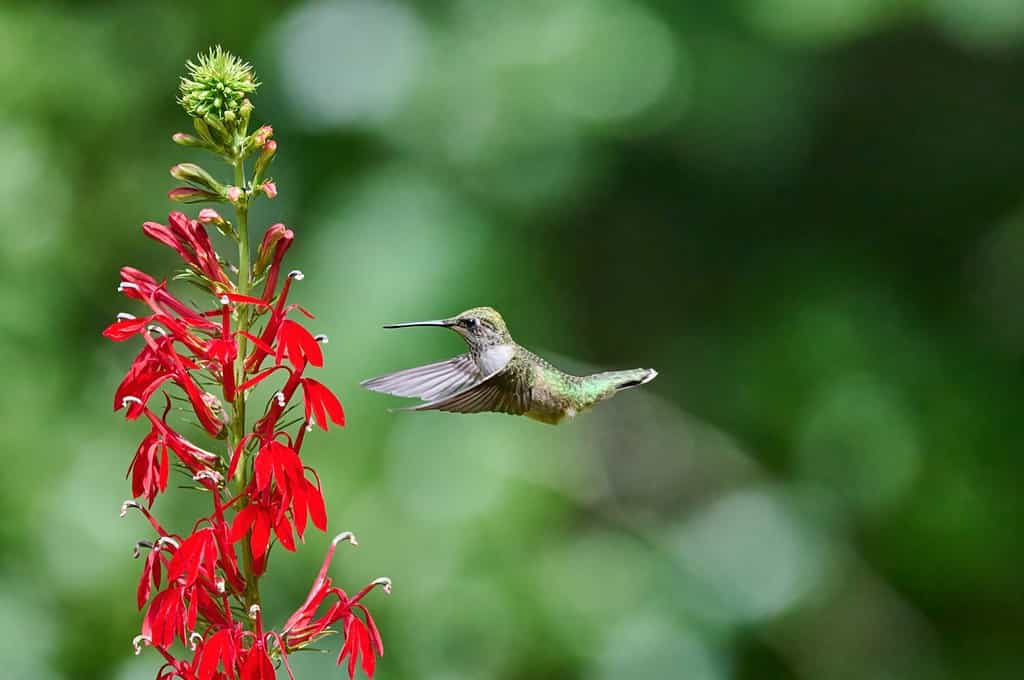
To add some color and life to your Illinois garden, plant the cardinal flower!
©Patrick Jennings/Shutterstock.com
Perfect for brightening up the garden as summer fades away, the cardinal flower stands out with its upright form, showcasing a cascade of striking red tubular blooms from midsummer through early fall.
These vibrant flowers sit on stalks, with alternating leaves, against a backdrop of shiny, lance-shaped green foliage. While the cardinal flower is robust, easy to care for, and generally free from pests and diseases, it might not last very long. However, in the right conditions, it can naturally produce more plants from its seeds without becoming invasive.
This flowering plant has received high praise, notably the prestigious Award of Garden Merit from the Royal Horticultural Society.
For optimal growth, the cardinal flower prefers nutrient-rich, consistently moist soil with a balance of sunlight and partial shade. It can even thrive in up to three inches of water. Sow its seeds in a warm spot once they’re ripe, or try using bud cuttings towards the end of summer.
Summary of Best Flowers to Plant in Illinois
| Number | Flower | Blooming Season |
|---|---|---|
| 1 | Tall Thimbleweed | Late spring to mid-summer |
| 2 | Common Milkweed | Early to late summer |
| 3 | Groundplum Milkvetch | Late spring to early summer |
| 4 | Cream Wild Indigo | Late spring to early summer |
| 5 | Wild Hyacinth | Late spring to early summer |
| 6 | White Turtlehead | Late summer to fall |
| 7 | Large Flower Tickseed | Late spring to late summer |
| 8 | Rock Harlequin | Late spring to fall |
| 9 | Robin’s Plantain | Mid-spring to early summer |
| 10 | Queen of the Prairie | Early to late summer |
| 11 | Water Avens | Late spring to late summer |
| 12 | Stiff Sunflower | Early summer to fall |
| 13 | Cardinal Flower | Mid-summer to early fall |
The photo featured at the top of this post is © Iva Vagnerova/iStock via Getty Images
Thank you for reading! Have some feedback for us? Contact the AZ Animals editorial team.







